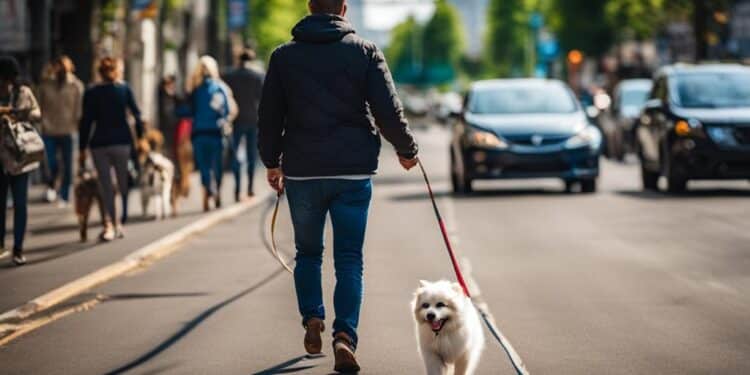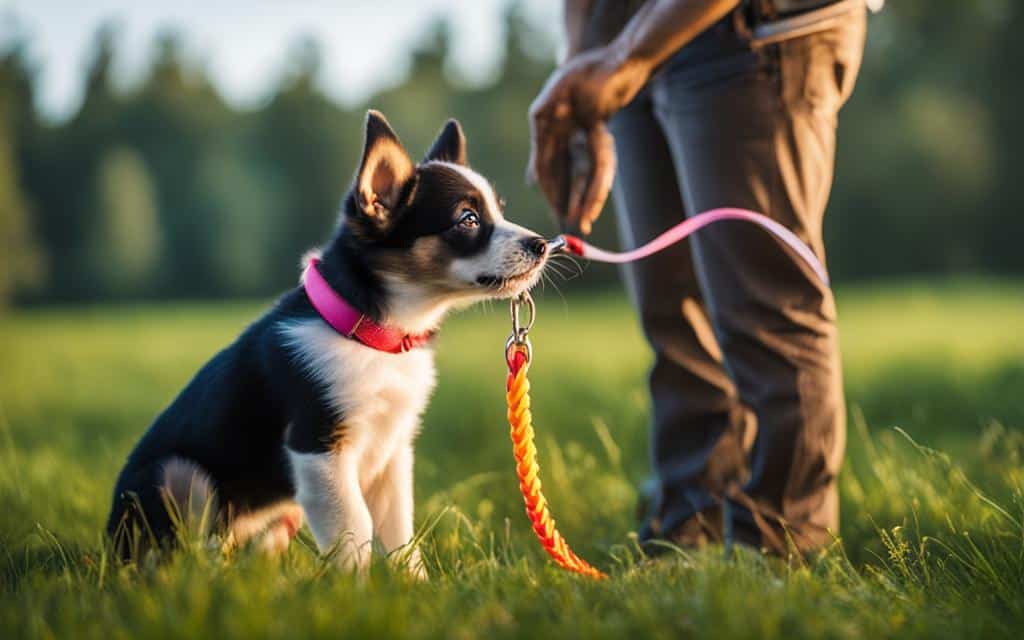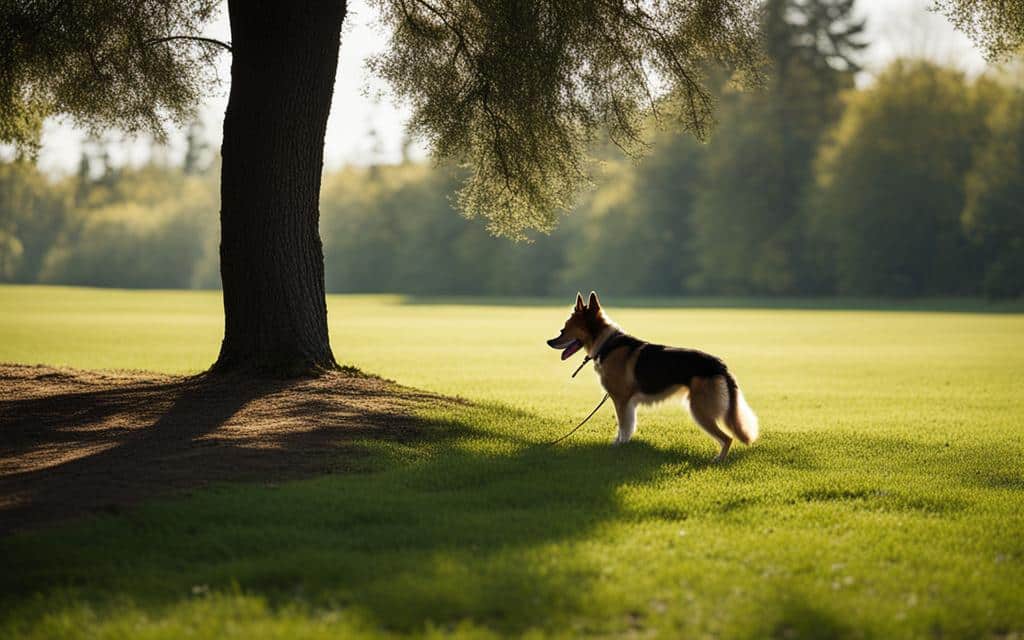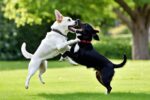Mastering Leash Training: A Guide for Dog Owners

Welcome to our comprehensive guide on leash training for dog owners. Leash training is a vital skill that enhances the safety and well-being of both dogs and their owners. In this article, we will explore the key steps to mastering leash training, including walking etiquette, choosing the right dog harnesses, and more. Whether you are a new dog owner or looking to improve your leash training techniques, this guide will provide you with valuable insights and practical tips.
Leash training is not just about keeping your dog under control during walks; it is also an opportunity to strengthen the bond between you and your furry friend. By effectively leash training your dog, you can ensure enjoyable and stress-free walks while maintaining proper walking etiquette in public spaces.
Throughout this guide, we will outline the essential steps involved in leash training, from choosing the right gear, introducing the leash gently, and starting with indoor training, to gradually exposing your dog to outdoor environments, using consistent commands, and managing pulling behavior.
Remember, leash training requires patience, consistency, and positive reinforcement. If you encounter challenges or feel the need for additional guidance, seeking professional help can make a significant difference in your training journey. Now, let’s dive into the first step: choosing the right gear for leash training.
Start with the Right Gear
Choosing the right gear is a crucial step in leash training your dog. The type of leash, collar, or harness you use can greatly impact your training success. When selecting your gear, consider the comfort and control it provides for both you and your furry friend.
First and foremost, opt for a standard 6-foot leash. This length provides enough room for your dog to explore while maintaining your control. A shorter leash may restrict movement, while a longer leash can lead to tangling or loss of control.
Next, focus on finding a collar or harness that fits well and is comfortable for your dog. A well-fitting collar should be snug enough to stay in place but not too tight to restrict breathing or movement. Alternatively, a harness distributes the pressure across the chest and back, reducing strain on the neck. Choose whichever option suits your dog’s size and breed.
It’s important to avoid retractable leashes during training. While retractable leashes offer freedom of movement, they can make it challenging to establish consistent control. The varying lengths and tension associated with retractable leashes can confuse your dog and hinder their learning process.
Remember, the right gear sets the foundation for successful leash training. Investing in a reliable leash and comfortable collar or harness is a choice both you and your dog will appreciate.
Introduce the Leash Gently
When it comes to leash training your dog, a gentle and gradual introduction is key to ensuring their comfort and success. By allowing your dog to sniff and get used to the gear, and starting with wearing the collar or harness indoors, you can create a positive association with the leash and prepare them for outdoor adventures.
Before attaching the leash, take the time to let your dog sniff and investigate the gear. Dogs rely heavily on scent, and this allows them to familiarize themselves with the leash. This step helps reduce any initial hesitation or anxiety.
Once your dog has had a chance to sniff and investigate the leash, start by having them wear the collar or harness indoors without attaching the leash. This allows them to become accustomed to the feeling of wearing the gear and helps them associate it with positive experiences. Use treats and praise to reinforce this positive association.
Remember, patience is key during this introductory phase. Allow your dog to take the lead and adjust at their own pace. Providing a calm and familiar environment will help them feel secure throughout the process.

By following these gentle introduction techniques, you set the foundation for a successful leash training journey with your dog. Now that your dog is comfortable wearing the gear, it’s time to move on to the next step: Initial Indoor Training. This will help your dog get used to walking on a leash in a controlled environment before venturing outdoors.
Initial Indoor Training
Getting Started Indoors
When it comes to leash training your dog, it’s best to start indoors where there are fewer distractions. This controlled environment allows both you and your furry friend to focus on the training process.
Begin by introducing your dog to the concept of walking on a leash. Put on their collar or harness and attach the leash. Let them sniff and get used to the gear before you start walking.
Encourage your dog with treats and praise as they take their first steps on the leash. Positive reinforcement helps them associate leash walking with a positive experience.
Take your dog on short walks around the house, making sure to reward them with treats and praise for their progress. This helps them get used to the feeling of being on a leash and builds their confidence.
Benefits of Indoor Training
Indoor training provides a safe and controlled environment for your dog to learn leash manners before venturing outside. It gives you the opportunity to establish a foundation of trust and communication with your dog.
“Indoor training allows you to focus on your dog’s behavior without distractions. It’s the perfect way to lay a solid foundation for outdoor walks.” – Samantha Adams, professional dog trainer
By practicing leash walking indoors, you can address any behavior issues in a controlled setting and reinforce positive habits. This sets the stage for successful training sessions outside the home.
Remember to be patient and consistent throughout the indoor training process. Leash training takes time, but with dedication and positive reinforcement, you and your dog will soon be ready to tackle outdoor adventures together.
Gradual Outdoor Exposure
Once your dog is comfortable being on a leash indoors, it’s time to gradually introduce them to outdoor environments. This part of the training process is crucial for helping your furry friend become familiar with new sights, scents, and sounds. Starting in a quiet area with minimal distractions will allow your dog to focus on learning and adapting to the outdoor environment.
One of the best places to begin your outdoor training journey is in St. Augustine’s parks. Known for their pet-friendly atmosphere and beautiful surroundings, these parks provide an ideal setting for you and your dog to practice leash training. The serene environment will help your dog stay calm and focused, promoting effective learning and positive experiences.

Benefits of St. Augustine’s Parks for Training
Training your dog in St. Augustine’s parks offers numerous benefits:
- Ample space to practice leash walking and commands
- Opportunities for socialization with other dogs and pet owners
- Varied terrain and natural elements to enhance training experience
- A pleasant and enjoyable environment for bonding with your dog
By utilizing the parks in St. Augustine, you’re providing your dog with an enriching training experience that goes beyond the confines of your home. This exposure to outdoor environments will help your dog build confidence, improve their walking etiquette, and enjoy exploring the world alongside you.
Remember to prioritize your dog’s comfort and safety throughout the training process. Keep an eye on their body language and adjust the training intensity as needed. Every dog is unique, and they may require different levels of exposure and time to adapt to outdoor environments.
| Benefits of St. Augustine’s Parks for Training |
|---|
| Ample space to practice leash walking and commands |
| Opportunities for socialization with other dogs and pet owners |
| Varied terrain and natural elements to enhance training experience |
| A pleasant and enjoyable environment for bonding with your dog |
Training your dog in St. Augustine’s parks offers a win-win situation: you get to immerse yourself in the beauty of the surroundings while providing your furry companion with essential outdoor training. Take advantage of these pet-friendly parks and create lasting memories as you master leash training together.
Consistent Commands and Signals
During leash training, it is essential to use consistent commands and signals to establish clear and effective communication with your dog. By employing consistent commands, you can provide guidance and create a structured environment for your furry friend.
Commands like “let’s go,” “stop,” and “wait” can be immensely helpful in teaching your dog proper leash-walking etiquette. When using these commands, be consistent in both your choice of words and tone of voice. This consistency will help your dog understand and respond to the commands more effectively.
“Let’s go.” “Stop.” “Wait.”
By incorporating these helpful commands into your leash training routine, you can establish a strong foundation for a successful walking experience. Your dog will learn to associate these commands with specific behaviors, making it easier for you to guide them during walks.
Clear and Consistent Communication
Clear and consistent communication is crucial throughout the leash training process. When giving commands, use a firm yet gentle tone and maintain a calm demeanor. Avoid yelling or using aggressive language, as this can confuse and stress your dog.
Additionally, ensure that your body language aligns with your verbal commands. Use consistent hand signals or gestures to reinforce your dog’s understanding of the desired behavior. By combining verbal commands with corresponding hand signals, you provide a clear and comprehensive message to your furry companion.
Building a Positive Connection
Consistent commands and signals not only provide structure during leash training but also help build a positive connection between you and your dog. By consistently using the same commands and signals, you establish a sense of trust and understanding.
Remember to reward your dog with praise, treats, or both when they respond correctly to your commands. Positive reinforcement strengthens the bond between you and your furry friend and encourages them to continue following your instructions.
Implementing consistent commands and signals creates a harmonious walking experience for both you and your dog. It fosters a sense of cooperation and allows you to guide your furry friend effectively. Let’s embark on a successful leash training journey by utilizing clear, consistent communication and helpful commands.
Managing Pulling Behavior
One of the common challenges dog owners face during leash training is dealing with pulling behavior. When a dog pulls on the leash, it can be frustrating and make walks less enjoyable. However, there are effective techniques that can help manage and correct this behavior.
If the dog pulls on the leash, it’s essential to stop walking immediately and stand still. This sends a clear message to the dog that pulling will not get them where they want to go faster. By not giving in to their pulling behavior, you are teaching the dog that pulling is not an effective way to move forward.
Waiting until the leash is slack before starting again is crucial. This ensures that the dog learns to associate loose leash behavior with moving forward. It may take some time and patience, but consistently reinforcing this concept will help the dog understand that pulling on the leash is unproductive.
Remember, leash training is a process that requires consistency and positive reinforcement. It’s important to stay patient and remain calm while working on managing pulling behavior. With time and practice, your dog will learn to walk calmly on the leash.
By implementing these techniques, you can teach your dog to walk politely on a leash while enjoying your walks together. Next, we’ll explore some additional strategies to enhance your leash training journey.
Conclusion
Mastering leash training is a crucial skill that enhances the quality of life for both dogs and their owners. With patience, consistency, and positive reinforcement, dogs can learn to walk politely on a leash, resulting in enjoyable and stress-free walks.
While leash training can be a rewarding process, it’s important to remember that professional help is available if needed. Sit Happens St. Augustine offers personalized training advice for dog owners seeking additional guidance or facing specific challenges during the training process.
Leash training in St. Augustine provides numerous benefits for dogs and their owners. This vibrant and pet-friendly city offers a plethora of parks, beaches, and outdoor spaces where dogs can safely enjoy their walks. From exploring the historic streets to meandering along the scenic coastline, leash training enables dogs to fully experience the beauty of St. Augustine alongside their owners.
FAQ
What gear should I use for leash training?
It is recommended to use a standard 6-foot leash and a comfortable, well-fitting collar or harness.
Should I use a retractable leash for leash training?
It is best to avoid using retractable leashes during training as they can make it difficult to maintain consistent control.
How should I introduce the leash to my dog?
Introduce the leash and collar/harness in a familiar, calm environment. Let the dog sniff and get used to the gear before putting it on. Initially, let them wear the collar or harness around the house without the leash attached.
Where should I start leash training?
Start leash training indoors where there are fewer distractions. Walk the dog around the house on the leash, encouraging them with treats and praise.
When should I start training my dog outdoors?
Once the dog is comfortable being on a leash indoors, gradually introduce them to outdoor environments. Start in a quiet area with minimal distractions. St. Augustine’s parks can be great training grounds as the dog becomes more comfortable.
What commands should I use during leash training?
Use consistent commands and signals during leash training. Commands like “let’s go,” “stop,” and “wait” can be helpful. Ensure clear and consistent communication each time you go for a walk.
What should I do if my dog pulls on the leash?
If the dog pulls on the leash, stop walking immediately and stand still. Wait until the leash is slack before starting again. This teaches the dog that pulling will not get them where they want to go faster.
What if I need professional help with leash training?
If you need assistance with leash training, seek professional help from experts like Sit Happens St. Augustine for personalized training advice.
What are the benefits of leash training in St. Augustine?
Mastering leash training enhances the quality of life for both the dog and the owner. Leash training in St. Augustine, a vibrant and pet-friendly city, can further enhance the experience of exploring the beautiful city with your canine companion.






